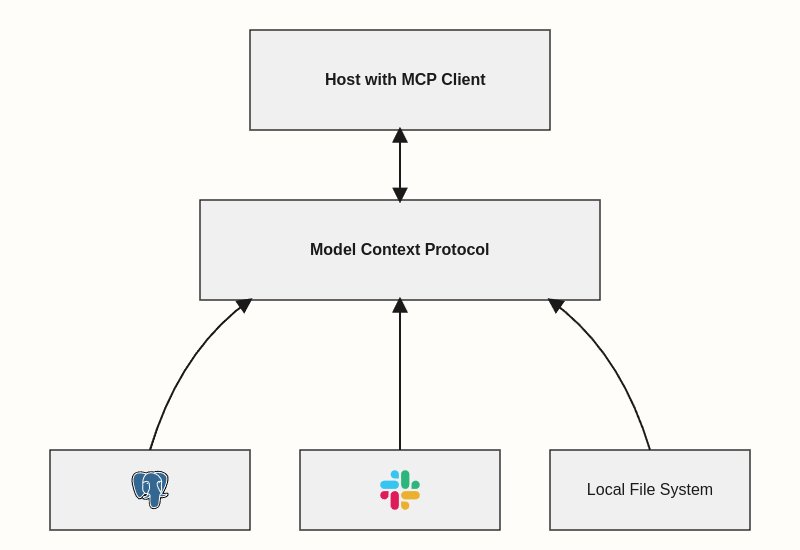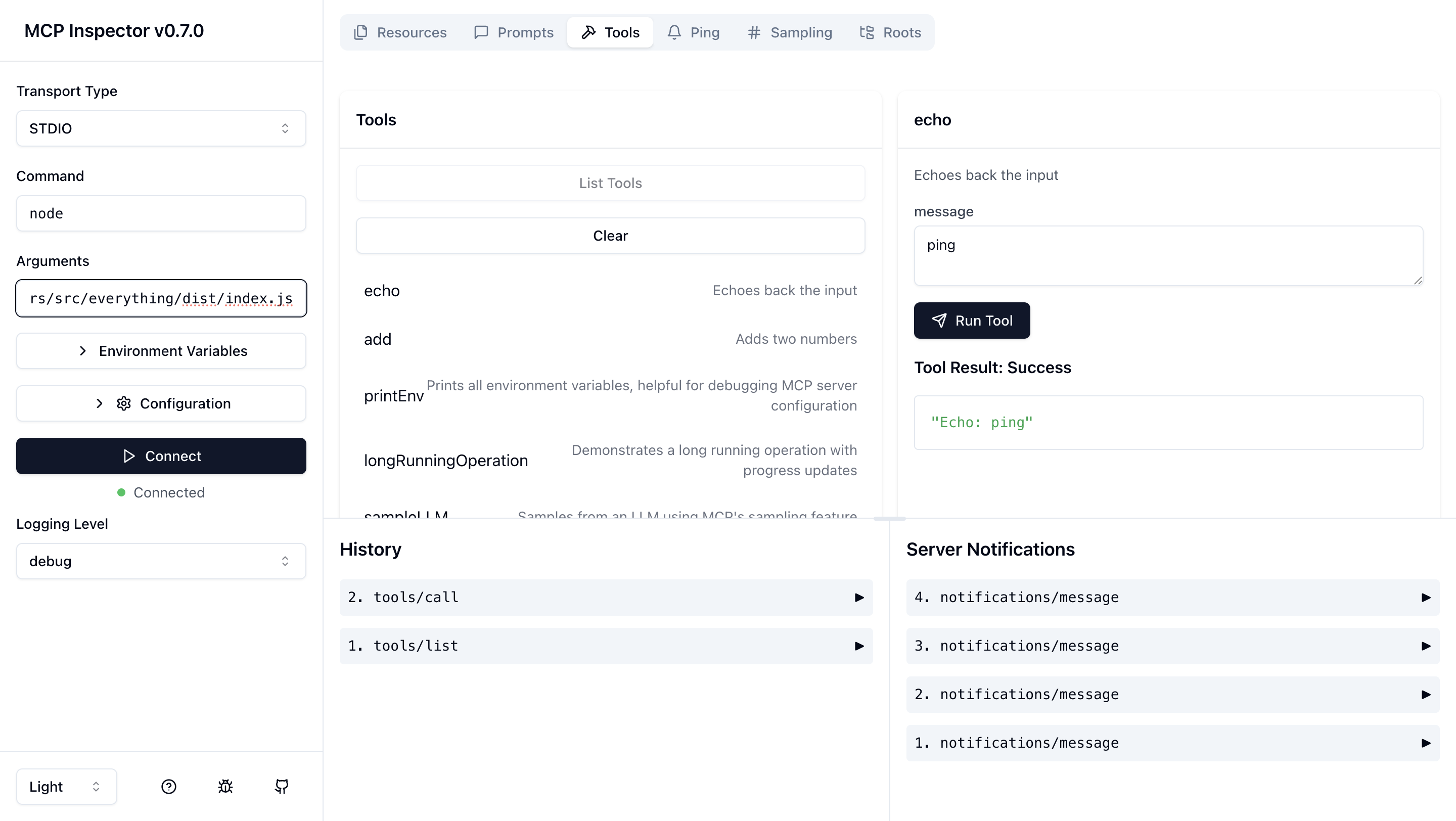Model Context Protocol (MCP): The Open Standard for AI Tool Integration
The Model Context Protocol (MCP) is an open standard designed to connect AI assistants and Large Language Models (LLMs) with external systems containing valuable data and functionality. Released in late 2024, MCP provides a universal way for AI assistants to securely connect and interact with external data sources, APIs, business software, and development tools.
Even advanced LLMs often operate in isolation, limited by the data they were trained on and disconnected from live information or the ability to act within external systems. Connecting AI to these services involves building custom, difficult-to-scale integrations for each data source. MCP solves this integration challenge by offering a universal, open protocol for secure, two-way communication. It effectively replaces fragmented, custom integrations with a single, standardized connection method - MCP standardizes how AI applications interact with external data and tools.
Why is the Model Context Protocol (MCP) Important?
MCP offers clear benefits for developers creating sophisticated AI agents and automating complex workflows with LLMs. Compared to other methods, MCP provides:
- Faster Tool Integration: MCP allows developers to quickly add new capabilities to AI applications. If an MCP server exists for a service (like a specific database or API), any MCP-compatible AI app can connect and use its functions without needing custom integration code. This plug-and-play approach speeds up automation, letting AI agents retrieve documents, query databases, or make API calls simply by connecting to the relevant server.

Model Context Protocol (MCP) Architecture - Enhanced AI Autonomy: MCP supports more autonomous AI agent behavior. It allows agents to actively retrieve necessary information or execute actions as part of multi-step workflows. Agents are no longer limited to their internal knowledge; they can interact directly with CRMs, email platforms, databases, and other tools in a coordinated sequence, bringing us closer to truly autonomous task completion.
- Reduced Integration Complexity: As a universal interface, MCP significantly lowers the effort needed to integrate new APIs or data sources. An application supporting MCP connects to numerous services via one consistent mechanism. This allows development teams to focus on core application logic instead of repetitive integration tasks, simplifying both development and maintenance.
- Improved Consistency and Interoperability: MCP uses a standardized request/response format based on JSON-RPC messages. This simplifies debugging, increases scalability, and ensures future compatibility. The interface to external tools remains the same even if the underlying LLM changes, protecting development investments.
- Rich, Two-Way Contextual Interaction: MCP supports ongoing communication and context sharing between the AI model and external servers. Beyond simple function calls (Tools), servers can provide Resources (contextual data) and Prompts (structured templates). This enables more sophisticated interactions, like providing reference data to the model or guiding it through predefined workflows.
Understanding the Core MCP Architecture
MCP operates on a flexible client-server model designed for extensibility:
- Hosts: These are the primary LLM applications (e.g., AI assistants like Claude Desktop, IDE plugins) that initiate MCP connections.
- Clients: Protocol clients run within the host application, managing individual connections to MCP servers. These clients are embedded directly into chatbots, coding assistants, or automation agents.
- Servers: Lightweight programs that expose specific capabilities (Resources, Tools, Prompts) via the MCP standard. Servers act as secure bridges between the AI application (via the client) and external systems.
- Local Data Sources: Data stored on the user's machine (files, local databases, services) that MCP servers can securely access based on permissions.
- Remote Services: External systems are accessible over networks (e.g., web APIs, cloud databases) to which MCP servers connect.
In this setup, the AI application (Host) includes an MCP Client. Each external service connects via a dedicated MCP Server. The server lists its available capabilities, and the client connects to use them. The AI model does not communicate directly with external APIs; instead, all communication follows the standardized MCP client-server process for structured and secure exchanges.
Key MCP Concepts Explained
MCP is based on several core ideas that structure how clients and servers interact
- Resources: Represent file-like data or content provided by servers. Clients and LLMs read resources to get context for tasks. Resource access is controlled by the host application, which decides how the data is used. Resources have unique URIs (e.g.,
file:///path/to/file,postgres://db/table,screen://active-window) and can contain text or binary data. Servers can also notify clients about changes to resources. - Tools: Executable functions offered by servers. Tools let LLMs interact with external systems, run calculations, or trigger actions. Tool use is typically controlled by the AI model, intended for automatic execution (often with user approval for sensitive actions). Each tool includes a name, a description (for the LLM to understand its purpose), and an input schema (using JSON Schema). The server contains the logic for executing the tool when called. Tool definitions might include annotations like
readOnlyHintordestructiveHintto indicate potential effects. - Prompts: Pre-defined templates or instructions provided by servers. Prompts assist users or LLMs in completing specific tasks more efficiently.
- Roots: URIs suggested by clients to servers to define relevant resource locations. Often, filesystem paths, roots can be any valid URI (like HTTP URLs). Servers should generally stay within the scope defined by these roots.
- Transports: The underlying communication mechanisms defining how MCP messages are exchanged between clients and servers. MCP uses JSON-RPC 2.0 as its standard message format.
MCP Message Types and Transport Options
Communication within MCP relies on JSON-RPC 2.0 messages, falling into four main categories:
- Requests: Messages sent from one party expecting a response from the other. They include a method name and parameters.
- Results: Messages confirming a successful request, including the response data.
- Errors: Messages indicating a request failed, providing an error code and description.
- Notifications: One-way messages sent without expecting a response.
MCP supports different transport mechanisms:
- Stdio Transport: Uses standard input (stdin) and standard output (stdout). Ideal for local processes where the client and server run on the same machine. Common in quickstart examples.
- SSE Transport: Uses
HTTP POSTrequests for client-to-server messages and Server-Sent Events (SSE) for server-to-client messages (like notifications). This transport is suitable for remote connections over networks.
Developers can implement custom transport layers if they adhere to the defined Transport interface.
Implementation Resources: SDKs and Examples
To simplify development, MCP provides Software Development Kits (SDKs) for popular programming languages:
Quickstart guides and examples are available here, showing how to build MCP client applications (connecting to servers, listing tools, sending requests) and MCP server applications (initializing the server, defining handlers for list_tools, call_tool, etc.).
Debugging and Troubleshooting MCP Integrations
Effective debugging is essential when working with MCP. The ecosystem provides tools and guidance:
- MCP Inspector: An interactive tool built for debugging MCP servers. It gives a detailed view of messages passed between clients and servers.

MCP Inspector Tool - Best Practices: Effective debugging involves detailed logging of protocol activity, tracing message flow, setting up server health checks, and testing different transports and error conditions.
Secure Authentication with OAuth 2.0
A key improvement in MCP is adopting OAuth 2.0 for secure authentication. Earlier versions lacked a standard method, making secure remote connections difficult and often requiring manual credential handling.
Using OAuth 2.0 provides a reliable and standard framework for secure interactions, particularly for remote servers and multi-user applications. Key advantages are:
- Standardized Security: Uses the established OAuth 2.0 protocol.
- Dynamic Client Registration (DCR): Allows clients to register with authorization servers automatically.
- Automatic Endpoint Discovery: Simplifies setup by allowing clients to find necessary OAuth endpoints.
- Secure Token Management: Ensures safe handling of access tokens, limiting client access to authorized resources only.
This standardized approach significantly improves security and ease of use.
How MCP Compares to Other Integration Approaches
MCP offers a distinct approach compared to other ways of connecting LLMs to external systems:
- Custom Integrations: MCP removes the need for building fragile, labor-intensive, single-use integrations for each service by providing a reusable, standard protocol.
- ChatGPT Plugins: While an early step, ChatGPT plugins were proprietary, linked to OpenAI, focused on single interactions, and lacked a universal authentication standard. MCP is an open, model-neutral standard supporting persistent connections and standard OAuth 2.0 security.
- LLM Tool Frameworks (e.g., LangChain, LlamaIndex): Frameworks like LangChain offer useful tools for developers building AI agents but often still need custom code for specific tool implementations. MCP works alongside these frameworks by standardizing the communication protocol between the AI application and the tool server. This lets agents built with frameworks like LangChain (which supports MCP) dynamically find and use any MCP-compliant server, moving standardization from the agent's code to the connection layer.
MCP provides an open, model-agnostic protocol that simplifies integration and authentication, providing a more scalable and interoperable solution than framework-dependent or proprietary options.
Real-World MCP Applications and Community Engagement
MCP allows AI systems to securely access and utilize live data and perform actions. Developers are already building MCP servers for common tools:
- Brave Search
- Slack
- GitHub
- Databases (PostgreSQL, Redis)
- File systems
These examples show MCP's value in connecting AI agents to company data, developer tools, communication platforms, and essential business systems.